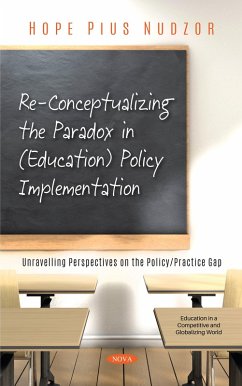A review of current (education) policy and practice endorses the view of an apparent paradox in policy implementation. Although tremendous investments (in terms of energy, time, and financial resources) are made in enacting policies, there is ample evidence to suggest that policy actors are impervious to policy information. Change agents and implementers of policy are often seen as pursuing different agendas when it comes to the task policy implementation. As aptly asserted by Sabatier and Jenkins-Smith (1993, cited by Shulock, 1999, p. 228), 'policymakers and implementers' core beliefs are unaffected by policy information, major policy change results rather from external factors such as inflation and elections. This book re-conceptualizes this policy phenomenon for rumination. The book essentially unravels perspectives on the policy implementation paradox, and through that exemplifies the 'best' suited approach for demystifying the policy/practice gap to bring understanding to the messiness and contested nature of (education) policy processes. To help draw conceptual leverage on the phenomenon described as the 'policy implementation paradox', this eight-chapter book performs two major functions. Chapters 1 to 4 set the context for the book. Chapter 1 defines (education) policy, and in the process, the traditional problem-solving definition of policy is juxtaposed with the process model, and through that a third conception (i.e., the theoretical eclecticism approach) is gauged to help provide both practical and theoretical bases for understanding how policy and practice exist in dynamic and iterative relationships. Chapters 2 and 3 give insights into how education policymaking is made and implemented respectively to unravel some of the influences on policy processes. Chapter 4 explicates (from within relevant literature) the policy paradox to assist readers to understand perspectives that are advanced in latter chapters to unravel and/or explain the existence or occurrence of this policy phenomenon. Second, Chapters 5 to 7 draw on literature from disparate sources to unravel perspectives on the policy implementation paradox, whilst Chapter 8 presents the key messages that are tangential to achieving the objectives of the book. Overall, the Chapter 8 performs three functions, namely it: summarizes perspectives presented in the scholarly literature to demystify and unravel the policy implementation paradox illustrates the reasons for the choice of the post-modernist perspective as the most appropriate and/or best suited perspective for unravelling this policy phenomenon; and outlines the relevance (and/or justifications) of the post-modernist conception of policy as both 'text' and 'discourse' as a framework for understanding the policy implementation paradox and the dynamism of policy processes at large.
Dieser Download kann aus rechtlichen Gründen nur mit Rechnungsadresse in A, B, BG, CY, CZ, D, DK, EW, E, FIN, F, GR, HR, H, IRL, I, LT, L, LR, M, NL, PL, P, R, S, SLO, SK ausgeliefert werden.









